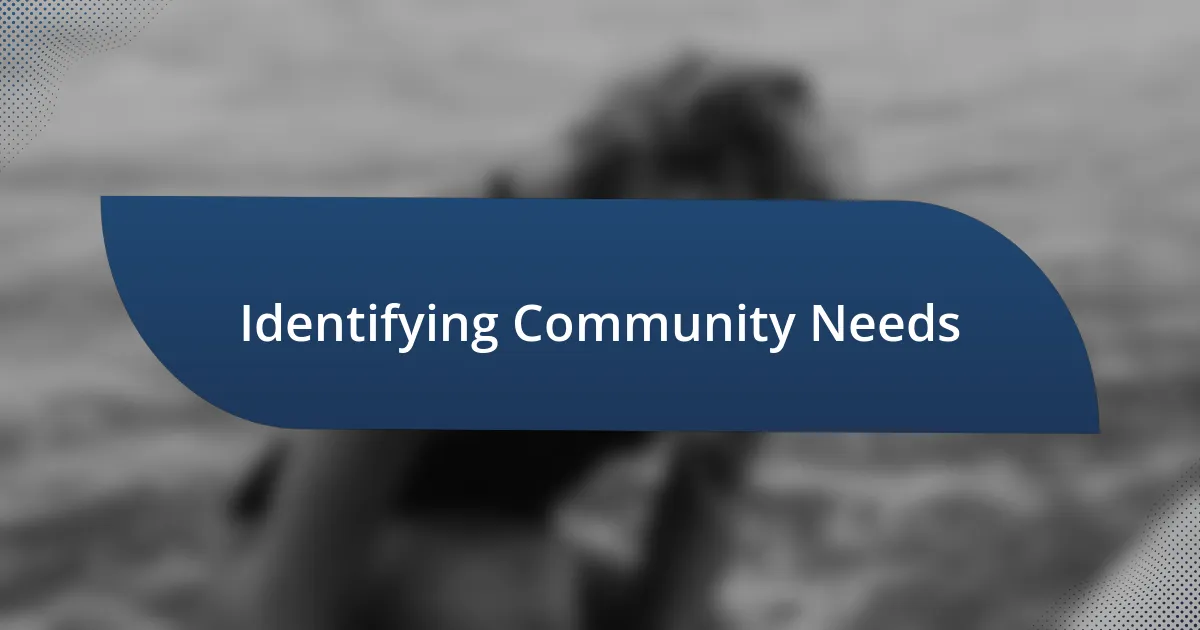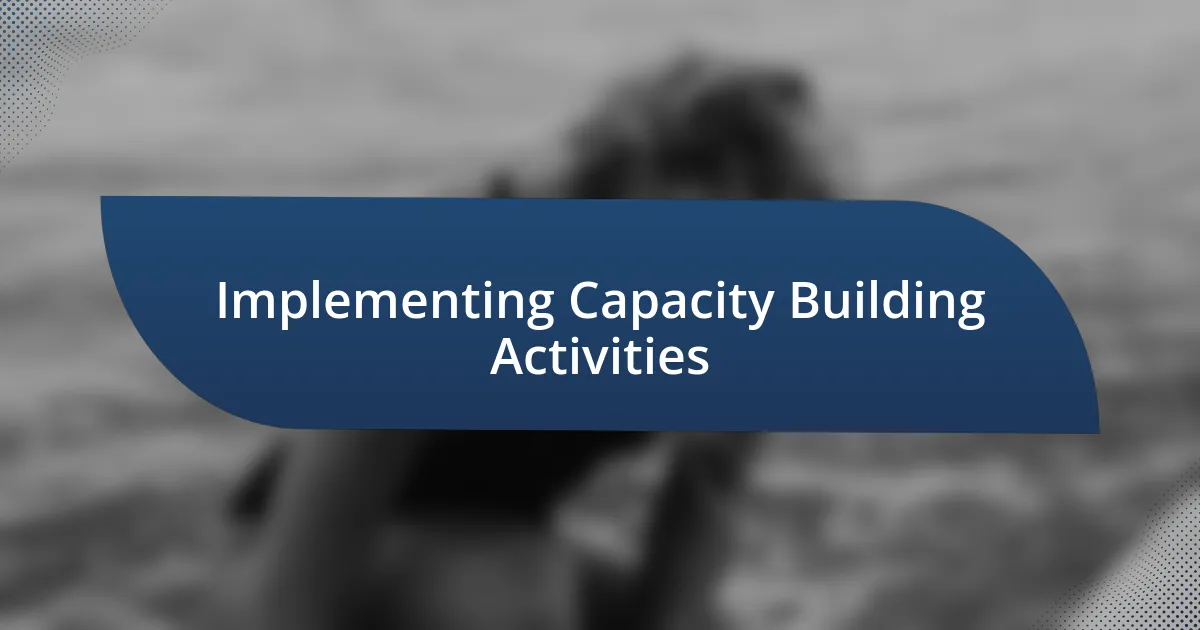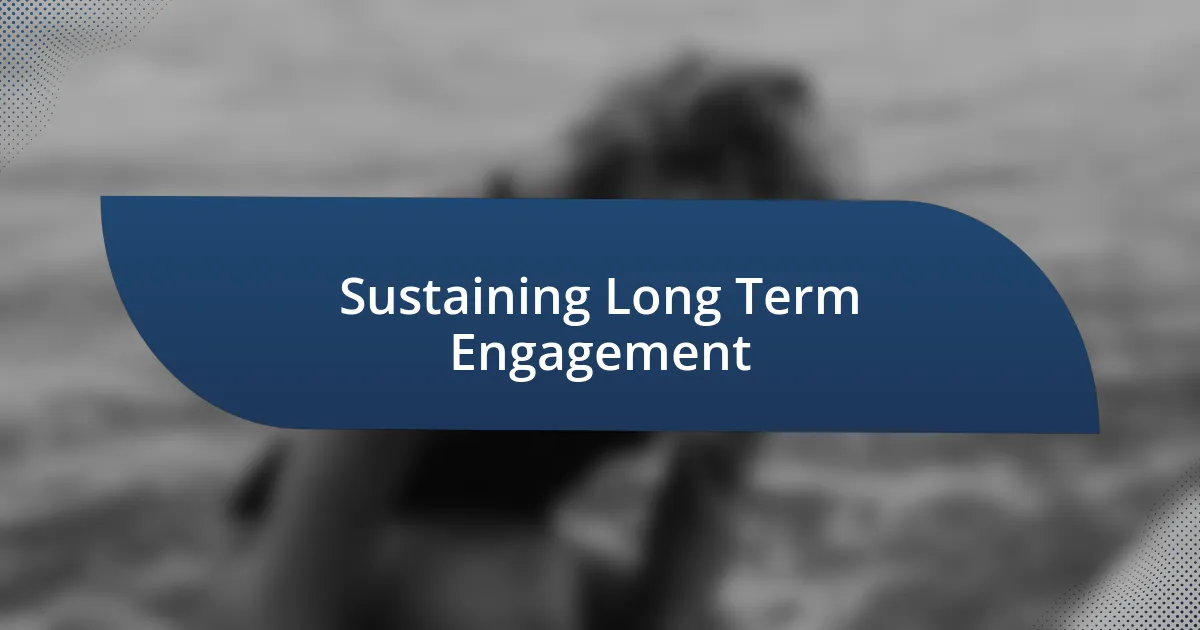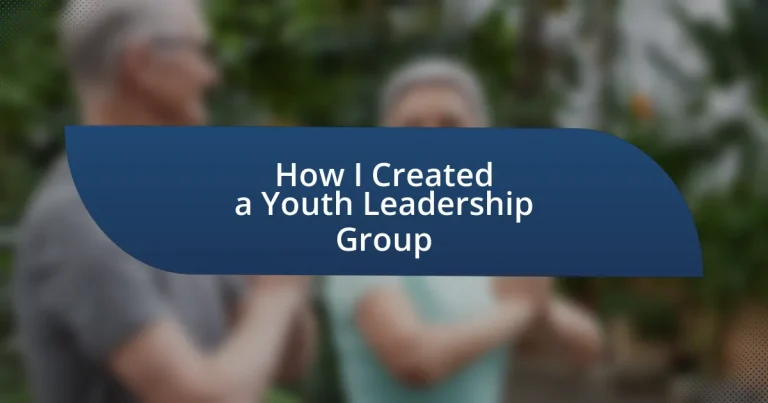Key takeaways:
- Engaging directly with community residents reveals critical needs and fosters a deeper understanding of barriers faced by youth.
- Recruitment of passionate participants is essential for group dynamics; creating an inclusive environment enhances belonging and motivation.
- Establishing clear short-term and long-term leadership goals fosters ownership and drives purposeful action among group members.
- Implementing mentorship and peer-led training activities empowers young leaders, promoting confidence and personal growth.

Identifying Community Needs
To effectively identify community needs, I found that engaging with local residents was essential. One evening, I attended a community meeting and heard firsthand accounts from people about their struggles and aspirations. This experience opened my eyes; how often do we overlook the valuable insights those directly affected can offer?
I remember talking to a young single mother who shared her challenges in securing childcare while pursuing further education. Her story resonated deeply with me, prompting me to question: What barriers are currently preventing our youth from accessing opportunities? It became clear that listening to such experiences reveals critical gaps that must be addressed.
In my journey, I learned that sometimes the most pressing needs are hidden beneath the surface. During a casual conversation at a local cafe, I discovered that many teens felt isolated and lacked safe spaces to connect and share their thoughts. How can we foster a community where everyone’s voice is valued? Recognizing and understanding these needs is the first step toward creating meaningful change.

Recruiting Passionate Participants
Recruiting passionate participants for my youth leadership group was a journey in itself. I realized early on that the right participants could make or break the group’s dynamic. One day, while volunteering at a local school, I came across a group of students who were brainstorming ideas for a community project. Their energy was infectious, and I could see they were eager to make a difference. It hit me that actively seeking out students who displayed a genuine interest in community issues was essential.
To effectively recruit, I focused on clear communication about the group’s mission and values. I also engaged with existing networks, such as schools and community organizations. Here’s what I found effective:
- Host info sessions where interested youth can learn more and ask questions.
- Use social media platforms to share inspiring stories and invite applications.
- Connect with teachers and youth leaders who can recommend motivated students.
- Create an inclusive environment that values diversity and unique perspectives.
By making the recruitment process interactive and inclusive, I aimed to create a sense of belonging from the very start. That made all the difference.

Establishing Leadership Goals
Establishing leadership goals is crucial for guiding the youth leadership group towards a common purpose. I remember sitting down with a few core participants after we formed, eager to define what we wanted to achieve together. We brainstormed goals that were not only ambitious but also realistic and aligned with our values as a team. This collaborative effort fostered ownership, making each member feel invested in our shared objectives.
I’ve learned that setting these goals involves balancing aspirations with practicality. We crafted short-term and long-term goals, which helped us measure our progress effectively. For instance, the immediate goal was to plan a community service project within the first three months, while a longer-term goal focused on developing leadership skills through workshops and mentorship. These clear targets created a roadmap that kept us motivated and focused.
Establishing leadership goals is more than listing aspirations; it is about cultivating a vision that resonates with every member. Reflecting on our discussions, it became clear that while our aspirations were diverse, a unified vision emerged. This clarity not only aligned our efforts but also inspired us to pursue excellence. It was powerful to witness how setting specific goals transformed our initial enthusiasm into purposeful action.
| Goal Type | Example |
|---|---|
| Short-term | Plan a community service project |
| Long-term | Develop leadership skills through workshops |

Developing a Leadership Curriculum
Developing a leadership curriculum is a nuanced task that requires careful consideration of the unique needs of the participants. As we crafted our curriculum, I reflected on my own experiences and realized the importance of incorporating hands-on activities alongside theoretical knowledge. After all, how can young leaders truly grasp concepts of teamwork and communication without actually practicing them in a safe environment?
One memorable session involved role-playing scenarios where members had to navigate challenges they might face in leadership roles. I watched as they grappled with decision-making, and even stumbled at times, but those moments were invaluable learning experiences. It brought me joy to see them connect theory to practice, making the lessons stick in a way that mere lectures never could.
In collaboration with our members, we included topics like conflict resolution and ethical leadership, making sure to adapt based on their feedback. This dynamic approach made me realize something powerful: when youth see their own voices reflected in the curriculum, they become more engaged and motivated. Isn’t it remarkable how education can transform when learners feel personally invested in their journey?

Implementing Capacity Building Activities
Implementing capacity building activities is essential for fostering the growth of young leaders. One effective approach I adopted was organizing workshops focused on real-world challenges. During one workshop, participants worked together to develop a community project proposal, and I was genuinely impressed by their creativity and collaboration. It was fascinating to see how they built on each other’s ideas, transforming individual thoughts into a cohesive plan.
Another impactful activity was a mentorship program that paired young leaders with experienced professionals. I still remember the excitement on their faces when they met their mentors for the first time. Witnessing these relationships develop was rewarding, as they gained not only knowledge but also confidence to express their opinions and navigate complex discussions—skills that are crucial in any leadership journey.
To ensure sustainability, we also incorporated peer-led training sessions. These sessions allowed participants to share their strengths, and I found that they often rose to the occasion, displaying skills they didn’t even realize they had. Isn’t it empowering to see someone surprise themselves with their capabilities? This kind of empowerment is key to building a resilient Leadership Group that thrives on shared learning experiences.

Measuring Group Impact
Measuring the impact of a youth leadership group is not just about tracking attendance or completing activities; it involves assessing personal growth and collective outcomes. I recall a time when we implemented reflection sessions after each major event. Participants shared how their perspectives had shifted, revealing insights into their emotional journeys and newfound confidence. It was a powerful reminder that true impact often unfolds in ways we might not expect.
Additionally, we created a feedback loop that encouraged participants to voice their experiences. I remember one young leader who expressed feeling more empowered to tackle social issues after completing a project. That moment underscored the importance of listening to their narratives; these stories are invaluable metrics for measuring growth and effectiveness over time.
Ultimately, observing shifts in behavior and engagement can be a profound indicator of impact. I often ask myself, how do we know we’re truly making a difference? When I see participants stepping up to lead initiatives or support their peers, it feels like tangible proof of success. These moments of transition are not merely benchmarks; they highlight the positive ripples our efforts create within the broader community.

Sustaining Long Term Engagement
To sustain long-term engagement in a youth leadership group, it’s essential to foster a sense of ownership among participants. I remember when we shifted from a top-down model to one where the members themselves began to curate agendas and lead discussions. It was incredible to witness their enthusiasm grow as they took charge, turning our meetings into platforms for their ideas and passions. When young people feel that their voices truly matter, they’re far more likely to remain invested.
Another key strategy I’ve found effective is the incorporation of mentorship. By pairing experienced members with newcomers, we created a supportive environment that reinforces relationships and encourages ongoing participation. I still think back to the bonds formed during one of our retreats, where mentors shared their journeys candidly. Witnessing those connections flourish provided a powerful reminder that engagement often thrives in a culture of support and shared experiences.
Moreover, recognizing and celebrating achievements—big and small—can significantly enhance commitment. I fondly recall a simple acknowledgment at one of our meetings where we celebrated a member who initiated a community project. The joy on their face was palpable, and it inspired others to seek out leadership opportunities. Isn’t it interesting how a small act of recognition can ignite a ripple effect of motivation? Engaging youth over the long term is not just about activities; it’s about creating an ecosystem of support, growth, and shared celebration.





